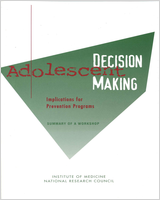NCBI Bookshelf. A service of the National Library of Medicine, National Institutes of Health.
This report summarizes the discussions held at the workshop. It provides a brief overview of decision theory and how decision theory might be applied to adolescent behavior. The report next considers cognitive, social, affective, and institutional factors that may influence effective decision making. The role of the media is briefly explored, followed by information on several youth development and prevention programs. Finally, the report summarizes issues that were raised throughout the workshop that might be important to the design and implementation of programs for youth.
Contents
This study was supported by Contract No. HHS-100-97-0028 between the National Academy of Sciences and the U.S. Department of Health and Human Services. Any opinions, findings, conclusions, or recommendations expressed in this publication are those of the author(s) and do not necessarily reflect the view of the organizations or agencies that provided support for this project.
NOTICE: The project that is the subject of this report was approved by the Governing Board of the National Research Council, whose members are drawn from the councils of the National Academy of Sciences, the National Academy of Engineering, and the Institute of Medicine. The members of the committee responsible for the report were chosen for their special competences and with regard for appropriate balance.
The National Academy of Sciences is a private, nonprofit, self-perpetuating society of distinguished scholars engaged in scientific and engineering research, dedicated to the furtherance of science and technology and to their use for the general welfare. Upon the authority of the charter granted to it by the Congress in 1863, the Academy has a mandate that requires it to advise the federal government on scientific and technical matters. Dr. Bruce M. Alberts is president of the National Academy of Sciences.
The National Academy of Engineering was established in 1964, under the charter of the National Academy of Sciences, as a parallel organization of outstanding engineers. It is autonomous in its administration and in the selection of its members, sharing with the National Academy of Sciences the responsibility for advising the federal government. The National Academy of Engineering also sponsors engineering programs aimed at meeting national needs, encourages education and research, and recognizes the superior achievements of engineers. Dr. William A. Wulf is president of the National Academy of Engineering.
The Institute of Medicine was established in 1970 by the National Academy of Sciences to secure the services of eminent members of appropriate professions in the examination of policy matters pertaining to the health of the public. The Institute acts under the responsibility given to the National Academy of Sciences by its congressional charter to be an adviser to the federal government and, upon its own initiative, to identify issues of medical care, research, and education. Dr. Kenneth I. Shine is president of the Institute of Medicine.
The National Research Council was organized by the National Academy of Sciences in 1916 to associate the broad community of science and technology with the Academy's purposes of furthering knowledge and advising the federal government. Functioning in accordance with general policies determined by the Academy, the Council has become the principal operating agency of both the National Academy of Sciences and the National Academy of Engineering in providing services to the government, the public, and the scientific and engineering communities. The Council is administered jointly by both Academies and the Institute of Medicine. Dr. Bruce M. Alberts and Dr. William A. Wulf are chairman and vice chairman, respectively, of the National Research Council.
- NLM CatalogRelated NLM Catalog Entries
- Primary prevention of adolescent pregnancy.[Soc Work Groups. 1981]Primary prevention of adolescent pregnancy.Schinke SP, Blythe BJ, Gilchrist LD, Burt GA. Soc Work Groups. 1981 Spring-Summer; 4(1-2):121-35.
- Review Strategies for Scaling Effective Family-Focused Preventive Interventions to Promote Children's Cognitive, Affective, and Behavioral Health: Workshop Summary[ 2014]Review Strategies for Scaling Effective Family-Focused Preventive Interventions to Promote Children's Cognitive, Affective, and Behavioral Health: Workshop SummaryForum on Promoting Children's Cognitive, Affective, and Behavioral Health, Board on Children, Youth, and Families, Institute of Medicine, National Research Council. 2014 Sep 29
- Review Biological, developmental, and neurobehavioral factors relevant to adolescent driving risks.[Am J Prev Med. 2008]Review Biological, developmental, and neurobehavioral factors relevant to adolescent driving risks.Dahl RE. Am J Prev Med. 2008 Sep; 35(3 Suppl):S278-84.
- Review Harvesting the Scientific Investment in Prevention Science to Promote Children's Cognitive, Affective, and Behavioral Health: Workshop Summary[ 2015]Review Harvesting the Scientific Investment in Prevention Science to Promote Children's Cognitive, Affective, and Behavioral Health: Workshop SummaryForum on Promoting Children's Cognitive, Affective, and Behavioral Health, Board on Children, Youth, and Families, Institute of Medicine, National Research Council. 2015 Jan 26
- Review Innovations in Design and Utilization of Measurement Systems to Promote Children's Cognitive, Affective, and Behavioral Health: Workshop Summary[ 2015]Review Innovations in Design and Utilization of Measurement Systems to Promote Children's Cognitive, Affective, and Behavioral Health: Workshop SummaryForum on Promoting Children's Cognitive, Affective, and Behavioral Health, Board on Children, Youth, and Families, Institute of Medicine, National Research Council. 2015 Aug 21
- Adolescent Decision MakingAdolescent Decision Making
Your browsing activity is empty.
Activity recording is turned off.
See more...
